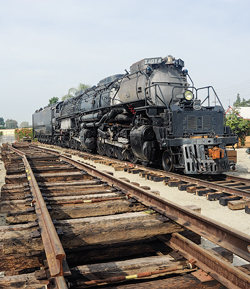|
Yes, you read the headline correctly. Courtesy of a U.S. State Department review, the last reasonable hurdle preventing approval of the Keystone XL pipeline has been eliminated. The review (fifth in a series since 2010), released late last month, found that no major environmental concerns remain. This takes away the main argument raised by pipeline opponents.
 |
Sitting on temporary track before its historic move, Union Pacific 4014 may point the way forward to a new generation of LNG-laden tenders (photo courtesy of Trains magazine: Jim Wrinn).
|
|
The report basically said that the Canadian oil sands are going to be developed, regardless of what action the U.S. takes on the pipeline issue. This is something that our Canadian friends have known for some time (see the article on Canada, page 72). In fact, an official noted that other options to transport oil from Canada to Gulf Coast refineries would actually be worse for climate change, including rail, trucks and barges.
Reaction from Keystone XL proponents was swift. Senate Minority Leader Mitch McConnell (Rep. – Ky.) said, “This report from the Obama administration once again confirms that there is no reason for the White House to continue stalling construction of the Keystone XL pipeline. So, Mr. President, nor more stalling—no more excuses.” Speaker of the House John Boehner (Rep. – Ohio) chimed in by saying, “President Obama is out of excuses.”
In Canada, where governmental officials and industry executives have been furious with the administration’s stalling tactics, Natural Resources Minister Joe Oliver did not hide his frustration. “This is the fifth federal study on the environmental impact of the Keystone XL pipeline,” said Oliver. “Each previous one has stated that building Keystone XL would not adversely affect the environment….The benefits to the U.S. and Canada are clear. We await a timely decision on this project.”
So, with all the heat generated by this verbal equivalent of a Bunsen burner, will the administration throw in the towel and approve the project soon? Not necessarily. In fact, our venerable contributing editor for Washington affairs, Roger Bezdek, tells us that he is now hearing from sources, that the administration may punt the decision and defer it to the next administration, all the way down to 2017 (see page 36).
Ultimate corporate preservation. Now for something more pleasant, and historic. On the night of Jan. 25-26, one of eight Big Boy steam locomotives still in existence, Union Pacific (U.P.) 4014 (see photo), underwent an impressive, 25-mi move from the Los Angeles County Fairgrounds in Pomona, Calif., eastward to maintenance shops at the railroad’s West Colton yard in Bloomington, Calif. The Big Boys are some of the largest steam locomotives built, and 25 of them were assembled for U.P. between 1941 and 1945.
U.P. has reacquired engine 4014 after it spent the last 51 years on display at the RailGiants Train Museum on the fairgrounds. The railroad plans to transfer the 4014 to Cheyenne, Wyo., where it will be restored further and become another actively working member of U.P.’s Steam Heritage program. This event is noteworthy for several reasons. One, unlike other engines of their time period, efforts to convert the Big Boys to burn oil failed. Two, there is no equivalent historical preservation program in the upstream oil and gas industry, save for the Offshore Energy Museum in Galveston. Three, the more-than-12-hr live coverage provided by Trains magazine was a significantly large, live streaming event, with 32,000 people watching nationwide in the middle of the night!
LNG-fueled locomotives. The giant tender trailing the Big Boy reminds us that a natural gas tie-in with railroads may soon reintroduce tenders behind modern-day locomotives. As discussed at the World LNG Fuels 2014 conference last month, railroads in the U.S. and Canada are looking seriously at replacing diesel with LNG to fuel locomotives. That’s because diesel can cost up to $2 more per gallon than the equivalent LNG volume. Union Pacific, alone, has said that it spent $3.6 billion on fuel in 2012. Encana President and CEO Doug Suttles told the conference that North American railroads, combined, could save $1.8 billion in annual fuel costs, just based on a savings of $1/gal, by switching from diesel to natural gas.
Some logistical challenges have to be overcome, before railroads switch fuels in earnest. One, very few LNG tenders have been built so far, and thousands will be needed. However, the Houston Chronicle reported recently that India-based INOXCVA is building LNG tenders at its plant in Baytown, Texas. Second, the railroads will have to build dozens of LNG fueling stations and other expensive infrastructure across their networks. Third, they will have to retrofit thousands of locomotives, but this would still be cheaper than building new versions at about $2 million, apiece.
Last, but not least, regulators in the U.S. and Canada have yet to act on safety issues related to tenders. The LNG must be cooled to -260oF, and the tender must vaporize the fuel and send the right quantity to the locomotive. Nonetheless, BNSF Railway and Canadian National Railway have been testing new tenders, and are looking at perfecting the right mix of diesel and LNG to burn in existing locomotives. 
|





